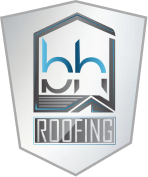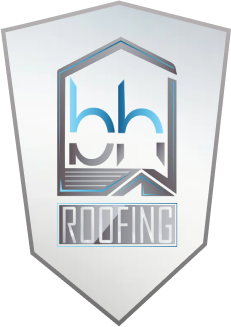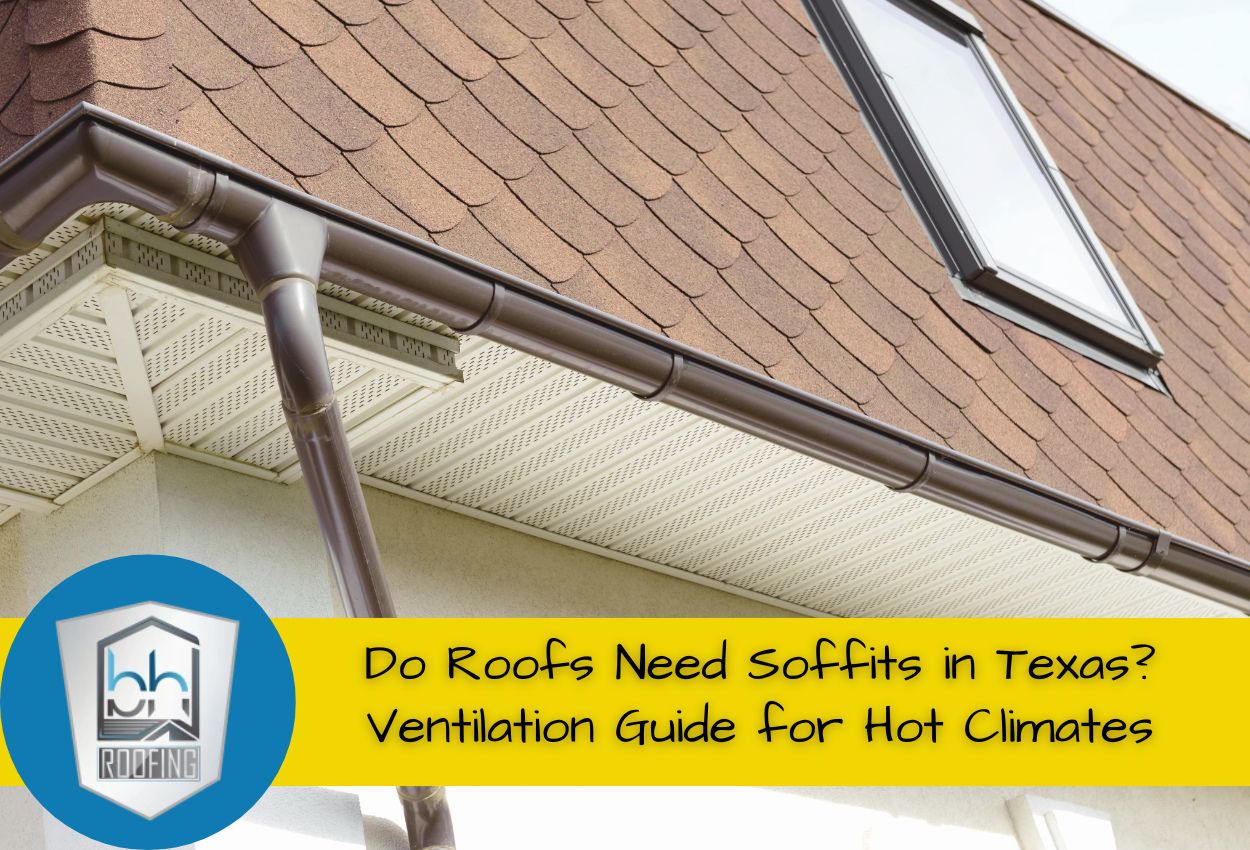Soffits are the finished underside of your roof’s overhang — the area between the edge of your roof and the exterior wall of your home. While often not the main focus during roof installation or replacement, these components play a vital function in maintaining your home’s structural integrity, especially in Texas’s challenging climate. Many San Antonio homeowners wonder if soffits are truly necessary in our region.
Contrary to what some believe, soffits aren’t just aesthetic additions — they provide crucial ventilation that helps regulate attic temperatures. In Texas, where temperatures regularly exceed 100 degrees Fahrenheit during summer, proper attic ventilation is essential for preventing heat buildup that can damage roofing materials and increase cooling costs. Soffits create a pathway for air to enter the attic space, working with ridge vents to establish constant airflow.
Beyond temperature regulation, soffits serve as a first line of defense against moisture intrusion and pest infiltration. The high humidity levels experienced across much of Texas make homes more vulnerable to moisture-related problems, including mold growth and wood rot. Understanding how soffits contribute to your roofing system’s performance can help you protect your home against our extreme weather conditions.
How the Texas Climate Affects Your Roof Ventilation Needs
Texas presents unique climate challenges that directly impact your roof’s ventilation requirements. With summer temperatures regularly soaring above 100 degrees Fahrenheit in San Antonio and across the state, your attic can quickly become an extreme heat trap. This accumulated heat doesn’t just make your home uncomfortable — it can warp roof decking, deteriorate shingles, and raise energy bills as your air conditioning system works overtime.
The humidity that accompanies Texas weather creates another challenge. When warm, moisture-laden air becomes trapped in poorly ventilated attics, it condenses on cooler surfaces, potentially leading to mold growth, wood rot, and insulation damage. During sudden storms and rain events common to the region, this moisture problem can worsen significantly.
Properly installed soffits provide the critical intake ventilation needed to combat these Texas-specific challenges. They allow cooler air to enter at the roof’s lowest point, creating a natural flow that pushes hot air out through ridge or gable vents. This continuous air movement helps keep attic temperatures steady — often reducing them by 20 to 30 degrees Fahrenheit compared to unventilated spaces.
For Texas homeowners, this temperature regulation translates to tangible benefits: extended roof lifespan, potential energy savings of up to 15% during peak summer months, and significant protection against moisture-related structural damage. The extreme temperature fluctuations in our climate make ventilation not just beneficial but absolutely necessary for roof longevity.
Building Codes and Regulations for Roof Ventilation in Texas
In general, Texas municipalities follow the International Residential Code (IRC) with specific amendments for roof ventilation requirements. The current standard mandates that attic spaces have a ventilation ratio of 1:300, meaning 1 square foot of net free ventilation area for every 300 square feet of attic space. This ratio should be equally split between intake vents, like soffit vents, and exhaust vents.
Homes lacking proper soffit ventilation systems are more likely to experience premature shingle deterioration and structural damage. The San Antonio Building Code specifically addresses the importance of balanced ventilation, emphasizing that soffit vents must remain unobstructed by insulation to maintain airflow.
These regulations recognize that proper intake ventilation at the eave level is crucial for attic temperature management in our extreme climate. Homeowners should be aware that retrofitting non-compliant ventilation systems may be required during major roof renovations to meet current code standards and prevent warranty issues with roofing materials.
Preventing Moisture Damage in Texas Homes with Proper Soffits
Moisture accumulation represents one of the greatest threats to Texas homes, particularly in the humid regions around San Antonio and the Gulf Coast. Without adequate soffit ventilation, attics become perfect environments for damaging moisture buildup. When warm, humid air becomes trapped in these enclosed spaces, it condenses on cooler surfaces like roof decking, rafters, and insulation. Over time, this persistent moisture leads to serious problems, including wood rot, mold growth, and compromised structural integrity.
Homeowners should watch for several warning signs that indicate moisture problems stemming from poor soffit ventilation. Visible water stains on ceiling drywall, peeling interior paint, musty odors in upper rooms, and frost formation in attics during winter are all red flags. More advanced symptoms include warped roof decking, rusted nail heads poking through shingles, and visible mold or mildew growth on attic surfaces. If insulation appears compressed or discolored, this often indicates long-term moisture exposure.
Correctly designed soffit systems prevent these issues by creating constant airflow that removes moisture before it can condense and cause damage. In Texas homes, vented soffits should account for approximately 50% of your total attic ventilation system, working in conjunction with ridge vents or box vents to establish effective ventilation. This means humid air doesn’t linger in your attic, protecting your home’s structural components and extending the life of your roofing materials.
Soffit Alternatives and Supplemental Ventilation Options
While traditional soffit vents provide excellent intake ventilation, not all Texas homes are designed with sufficient eave overhangs to accommodate them. Fortunately, several alternative and supplementary ventilation options can effectively maintain proper attic airflow in these situations. Understanding these soffit alternatives for Texas homes is essential for properties with architectural limitations or those seeking to improve their existing ventilation systems.
Drip edge vents remain one of the most effective soffit alternatives, providing exhaust ventilation along the edge of the roof, just above the gutters. When paired with exhaust vents like ridge vents or box vents placed below the peak, they can create effective air circulation even without traditional soffits. Gable vents positioned at the ends of attic spaces offer another option, though they work best when installed on opposite walls to promote cross-ventilation.
For Texas homeowners dealing with extreme heat, power vents can supplement passive systems during the hottest months. Solar-powered attic fans provide cost-effective boosted ventilation without increasing energy bills. Turbine vents, which spin with natural air currents, offer enhanced exhaust capacity that works well with minimal intake ventilation sources. When selecting alternatives, consider your specific roof design, local climate conditions, and the recommendation of experienced San Antonio roofing professionals to ensure optimal protection for your home.
Installation and Maintenance Considerations for Soffit Vents
Proper installation of roof soffits is crucial for Texas homes facing our extreme weather conditions. When installing soffits in San Antonio and surrounding areas, material selection becomes a primary consideration. Vinyl soffits offer affordability and good performance, but aluminum soffits provide superior durability against Texas heat. For homes in areas prone to severe storms, perforated metal soffits with smaller vent openings help prevent water intrusion while maintaining necessary airflow.
Installation configuration matters significantly in our climate. Soffit vents should be installed with sufficient clearance to roof insulation, ensuring unobstructed airflow paths from eave to ridge. For maximum effectiveness in the Texas heat, professional roofers typically recommend installing vented soffits along the entire eave line rather than alternating with solid panels, which maximizes cooling airflow during our hottest months.
A seasonal maintenance schedule helps ensure your soffits continue performing optimally year-round. In spring, inspect for winter damage and clear any debris from vent openings. Summer inspections should verify airflow and check for heat-related warping. Fall maintenance focuses on clearing accumulated leaves and debris before winter arrives. Throughout the year, watch for signs of pest intrusion, particularly wasps and hornets that frequently build nests in soffit areas across Texas. Regular maintenance prevents expensive repairs and ensures your ventilation system continues protecting your home through all Texas weather extremes.
Long-Term Benefits of Soffit Ventilation Systems for Texas Homeowners
Investing in professionally designed and installed soffit systems yields substantial long-term returns for Texas homeowners. Perhaps most significant is the extended roof lifespan — homes with adequate soffit ventilation typically see their roofing materials last longer than poorly ventilated alternatives. In the harsh Texas sun, this ventilation prevents shingles from reaching extreme temperatures that accelerate deterioration and curling, potentially saving homeowners thousands in premature replacement costs.
Energy efficiency represents another significant benefit. Well-ventilated attics with soffit systems can reduce cooling costs during summer. This cooling effect reduces the strain on air conditioning systems and helps maintain consistent indoor temperatures throughout the home.
In addition to immediate protection, quality soffit installations can improve property value in the competitive Texas real estate market. Homes with visible soffit damage or inadequate ventilation frequently receive lower appraisals and face longer selling periods. Visible soffit systems in good condition contribute to positive first impressions and curb appeal, with many buyers specifically looking for these features as indicators of well-maintained properties.
The protection against Texas-specific challenges, including humidity, heat waves, and severe storms, makes soffit systems an essential investment rather than an optional upgrade. Properly installed systems protect against wind-driven rain infiltration and provide critical defense against the moisture-related problems that plague many Texas homes.
Discover the Benefits of Soffits for Your Texas Home with BH Roofing
Understanding the critical role of soffits in your Texas roofing system is key to enhancing not only the functionality but also the longevity of your home. Soffits are more than just an aesthetic feature — they are essential in preventing moisture buildup and ensuring proper attic ventilation, crucial in the Texas heat. BH Roofing specializes in the installation and maintenance of high-quality soffits designed to withstand Texas’s climate.
Whether you’re dealing with high humidity or extreme temperature fluctuations, our expert team at BH Roofing ensures your soffits are perfectly installed to protect your home from moisture damage and improve energy efficiency. Don’t wait for ventilation issues to cause major damage. Call us today at (210) 267-9029 to learn how our soffit and roof ventilation services can benefit your home.


